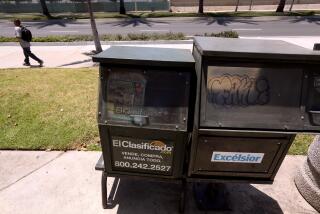4 Papers That Folded Restart Their Presses : Journalism: Community pressure and government support help rescue Southeast newspapers. They begin publishing Thursday.
- Share via
Through an unusual combination of government support, community pressure and business maneuvers, the presses are ready to roll again on four weekly Southeast papers that folded 18 months ago.
The papers, scheduled to hit the streets Thursday, will be published by the Los Angeles-based Wave Newspaper Group, which entered into a joint operating agreement between California’s two largest community newspapers in March, said Publisher Ric Trent. The agreement combined Urban Newspapers--formerly Southern California Community Newspapers--Northeast Newspapers and Central News-Wave Publications, a presence in South-Central for 80 years.
The agreement has created a 31-paper chain serving more than 635,000 households from Eagle Rock to Norwalk and Carson to Culver City, making it the nation’s second-largest weekly group after the St. Louis Suburban Journals, said Brian Hews, chief executive officer of the Wave group.
Readers should recognize the familiar Bell-Maywood, Cudahy Industrial Post, the Huntington Park Bulletin, the Bell Gardens Review and the South Gate Press when the free papers land on their doorsteps this week. The papers will begin much where they left off on Jan. 13, 1993, their publishers said, with their mastheads and missions intact.
The Southeast papers are the last in the chain to resume publication after a bank foreclosed on Southern California Community Newspapers in January, 1993. While the joint operating agreement has made it financially feasible for the papers to return, an outpouring of community and government support demonstrated a need for the papers. This reinforced Executive Editor and Publisher Art Aguilar and Publisher Trent in their efforts to bring the papers back.
“We’re (the communities’) only source for news that affects them,” Aguilar said. “That’s a huge responsibility. You’ve got to get this information out to these people.”
*
Within weeks after publication ceased, readers were asking their elected leaders to intervene to bring the papers back, demonstrating a sense of ownership and loyalty that illustrates the integral role the local paper plays in smaller towns, said Bryce Nelson, director of graduate studies at the USC School of Journalism.
“It exemplifies that newspapers are terribly important to building a sense of political and social community and that communities that don’t have them suffer a feeling of loss,” Nelson said. “Television and radio can’t fill that same need.”
The anticipated comeback is a relief to area residents who, though served by several larger newspapers, say they miss the focus of local coverage provided by hometown papers.
South Gate High School teacher Victorio Gutierrez had made a ritual of asking the City Council to bring a publisher to town.
“We asked them seven or eight times,” he recalled. “We told them that it was of vital importance to have a means of communication between city leaders and community.”
What Gutierrez and other residents didn’t know was that after the papers shut down, Trent and Aguilar scrambled to hold together what was left of their company until they could publish again.
Rhode Island Hospital Trust bank had foreclosed on Trent’s 20 area papers after Trent filed for bankruptcy to protect the chain from a lawsuit over a classified ad for housing that read “adults preferred.” After months of negotiation, Trent and Aguilar had believed the bank would accept an offer to purchase the chain for $1 million to be paid over a 13-week period.
The offer fell through and within hours, the locks on their offices were changed and 125 employees were on the street in the rain.
When the bank took over, the Wave offered to help Trent’s papers get financing if he consented to a joint operating agreement. Meanwhile, Trent and Aguilar rented computers and set up card tables in the offices of Northeast Newspapers, a separate company managed by SCCN.
While the chain’s newspapers in Alhambra, Downey and other cities came back within six weeks, the company lacked the financing to immediately bring back the Southeast papers. City leaders felt pressured to fill an information vacuum.
*
Several cities launched newsletters, some budgeting $12,000 annually. Huntington Park began the bimonthly Spectrum last August and the city of Bell started its Bulletin in February. In South Gate, newly elected Councilman Henry Gonzalez had planned to make good on a campaign promise to personally fund the city to print a newsletter.
In smaller Southeast cities, however, the information gap has remained. City newsletters in Maywood and Cudahy became budget casualties years ago and getting simple information to the public became a chore. To inform city children of park programs, Cudahy City Manager Jack Joseph resorted to sending flyers to school sites for distribution.
Residents in South Gate and Bell Gardens pressured city officials so much about the lack of information that the cities sent emissaries to encourage the papers to publish again.
Aguilar and Trent proposed that the cities, which traditionally take ads to publish legal notices and public service announcements, pay for advertising in advance to aid the papers with start-up costs.
The publishers asked for a guarantee of $20,000 in advance payments for advertising from each city. The Bell Gardens council rejected the proposal, saying its members didn’t like the coverage they received from the former Bell Gardens Review. But the South Gate council voted to immediately pay $20,000 now to cover advertising in the South Gate Press for the next few months.
While the newspapers would eventually have returned without the cities’ money, the support was critical, Hews said.
More to Read
Sign up for Essential California
The most important California stories and recommendations in your inbox every morning.
You may occasionally receive promotional content from the Los Angeles Times.










